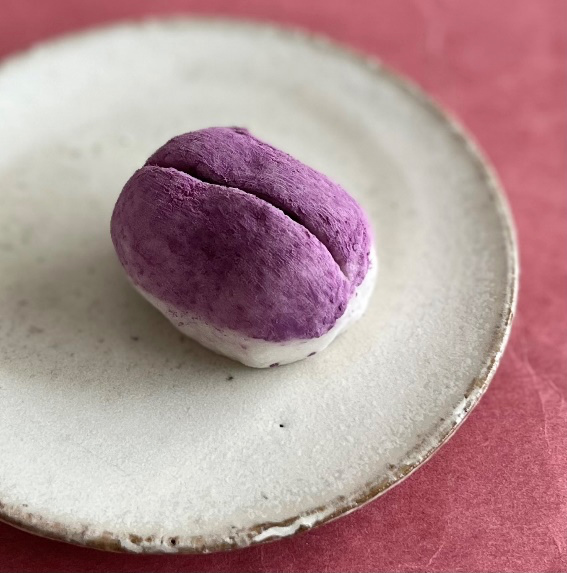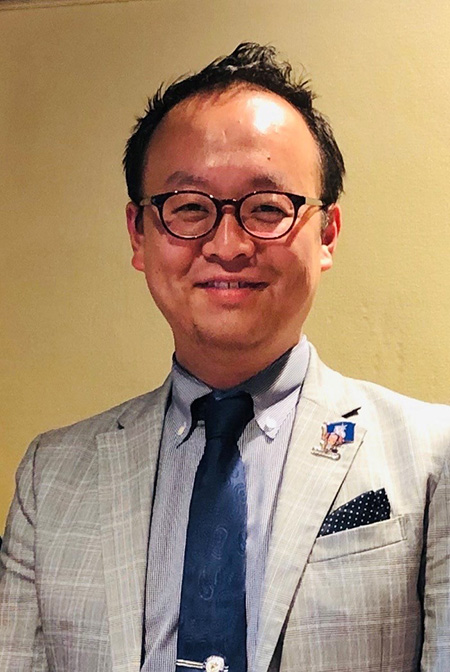World Wide WAGASHI~かわいい和菓子の世界~⑭
季節を感じて、まだ見ぬ実物を感じられる
Feel the Autumn Season with Sweets Shaped Like a Rare Fruit
文銭堂本舗の「山あけび」 330円

近いこともあって足繁く通うお店のひとつ、新橋の文銭堂本舗。
ふらりと立ち寄れば、曜日限定で販売される「豆大福」に出合えるという幸運。
そして、秋も深まってきますと忘れちゃいけないのが、この薯蕷饅頭。
それが「山あけび」というお菓子で、郷愁を帯びてさえいるお菓子でもございます。
たぶん、アケビと言っても、僕を含め多くの人はピンとこないかもしれません。
僕は親からよく聞いていたので知っていますが、実物を見たことはほとんどありません。
この形だけを見たら、小豆のような豆なのかなあと思う人もいるかもしれません。
それくらい見かける機会はなくなってしまいました。
ザクロもそうですが、木になる果実で、熟しますと、実が弾けて種が見えます。
こんな豆のような形をしていて、10センチくらいの大きさで淡い紫色の実なのです。
そう、果物で、ブドウ以外で紫色の果実ってあまりないですよね。
でも、ブドウのような濃い紫色ではなく、薄い紫色ってのがまた美しくて可愛い。
里山での野遊びするのが普通だった親の世代では、普通に子供のおやつだったし、東北ではピーマンじゃないですけれど、肉詰めして味噌で炒めたりして、山菜のような感覚で調理して食べるというのも見かけますが、都内ではまず見ないでしょうね。
ですので、この生菓子を見たところで、「アケビ? 何それ」と思う方も多いでしょうが、和菓子の大事なところは季節の実りを伝えることでもありましょうし、今は見かけなくなってしまったものが、こうして菓子になって伝えてくれるのは、実に魅力的でもあります。
そして、この「山あけび」を見たり、食べたりした方が、本物を探してくれたら嬉しいなあとも思います。
秋が深まってきた頃にこんな薄紫色の果実をつけ、縦に割れて、白い果肉と黒い種がたくさん見え、ほんのり甘い野趣味を表現しています。
さて、このお菓子は面長の薯蕷饅頭で、饅頭皮で粒あんと柔らかく炊いた栗を包んでいます。
表面には鮮やかな紫色がしっかりついているのですが、紫芋のパウダーを使用した天然色素によるもので、これが鮮やかで実に美しいのです。
薯蕷饅頭のしっとりとした風合いと香りと共に、秋の味覚である栗を隠し、見た目はアケビではありますが、そこに栗を忍ばせて秋を味わって感じさせる。
種子のつぶつぶと当たる感覚もまた、粒あんであることで表現されているようにも感じます。
ただ断面を確認すると、それだけではない、何かの存在に気付くのです。
饅頭皮の生地とあんこの間に、何やら薄いもっちりとしたものを感じます。
そう、外郎(ういろう)生地が隠れているのです。
それがまた白い果肉を思わせて、何とも言えない。
いやあ、何か保湿された弾力を感じ、断面を確認しなければ気付かないほど……。
でも、この構成がまたとっても素敵だなあと思わせるわけです。
※例年、9月上旬から10月末ごろまでの販売
Bunsendohompo’s ”Yama-akebi” ¥330~
I often go to Bunsendohompo in Shimbashi.
Although I like Mame Daifuku, which is only sold on certain days of the week, this grated yam manju sweet is the one I can’t forget as autumn deepens.
This very nostalgic Japanese WAGASHI sweet is called “Yama-akebi.”
The word “akebi” probably doesn’t resonate with many people, myself included.
Looking at the shape, some people might wonder if it is actually a bean.
I only know about it because I often heard about it from my parents, but I’ve almost never seen the real thing.
It is a light purple tree fruit shaped like a bean that grows to about 10 cm.
There aren’t many purple fruits other than grapes, but this fruit isn’t a deep purple like grapes, but a cute and lovely light purple fruit.
As autumn deepens, the fruit bursts open like a pomegranate to reveal white flesh with many black seeds, and has a sweet, slightly rustic taste.
When my parents were children, this fruit was often eaten as a snack in the countryside, and in Tohoku it is eaten stuffed with meat and stir-fried with miso, but you can’t find it in Tokyo these days.
That’s why many people think, “Akebi? What’s that?” when they see this fresh sweet. But conveying the bounty of each season is an important role that Japanese WAGASHI sweets play, so it’s really appealing to see a sweet that’s shaped like something that can’t easily be found anymore.
This sweet is made by wrapping chunky bean paste and soft cooked chestnuts in a bun.
The bright purple color on the surface is a natural pigment made from purple sweet potato powder, which is what makes it so bright and truly beautiful.
While it looks like akebi, the moist texture of the sweet potato bun has chestnuts hidden inside, giving it a feeling of autumn.
The feeling of seeds hitting the flesh is expressed through the feeling of the chunky bean paste.
But when you take a look at a cross section of the sweet, you can feel something thin and chewy between the bun and the bean paste.
That something is hidden. It’s hard to describe but it reminds me of the white pulp of the fruit. You can feel the gumminess, and the texture is so subtle that you would miss it if you didn’t check the cross section.
But it is this ineffable nature that makes me think this creation is such a wonderful Japanese WAGASHI sweet.
※Available from early September to October each year.
御菓子司 文銭堂本舗 新橋本店
https://bunsendohompo.com/
ADDRESS/東京都港区新橋3-6-14 TEL/03-3591-4441
OPEN HOUR/8:30〜18:30(土曜9:00~16:00) CLOSE/日曜・祝日

はた・ちから/47都道府県1000軒以上の和菓子店を実際に訪れ、10000種類以上の和菓子を食べてきた、髙島屋全店の和菓子担当バイヤー。2003年、髙島屋入社、2006年から和菓子売り場担当、2009年から和菓子担当バイヤーに就任。全国各地の和菓子のために奔走する日々。銘菓百選
また、リアルな和菓子情報を、InstagramやTwitterで発信中。著書に『ニッポン全国和菓子の食べある記』(誠文堂新光社)。
As WAGASHI buyer for all of Takashimaya’s stores, Chikara Hata has personally visited over a thousand WAGASHI shops in all of Japan’s 47 prefectures, and has sampled more than 10,000 kinds of WAGASHI. Hata shares information about authentic WAGASHI on Instagram and Twitter.
